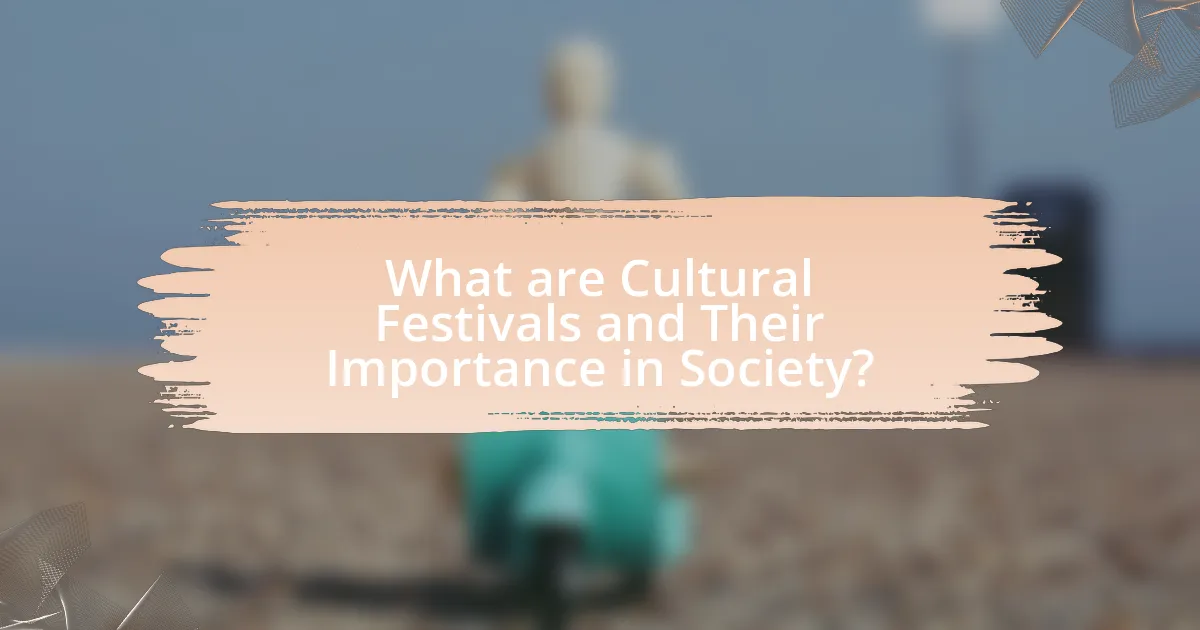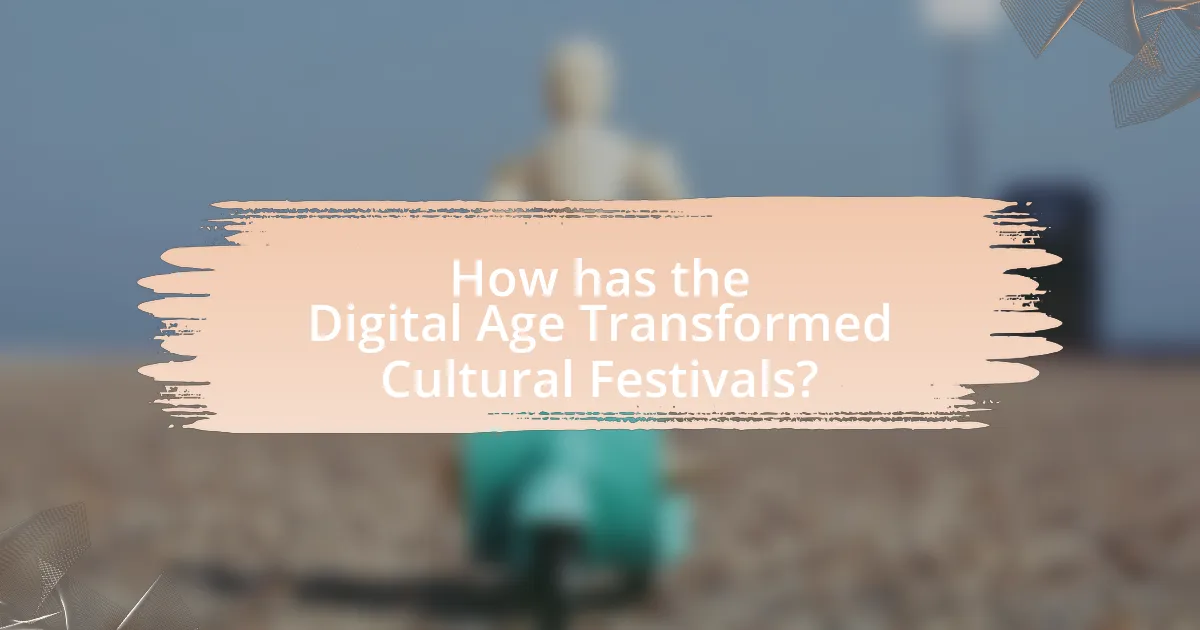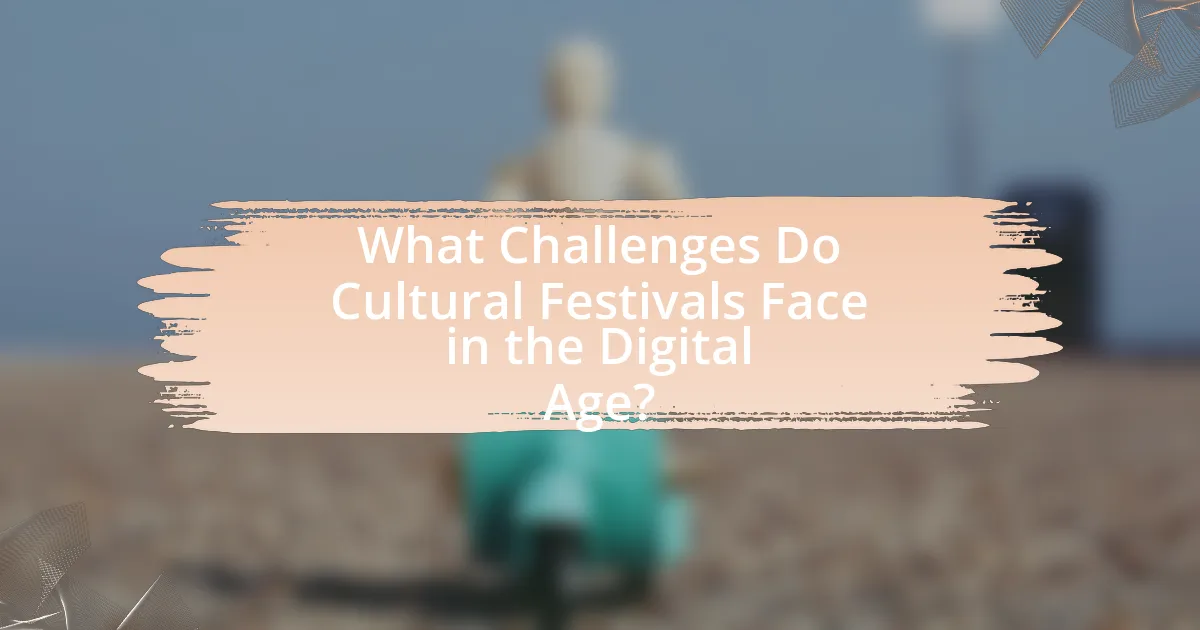Cultural festivals are organized events that celebrate the traditions, arts, and heritage of specific communities, playing a vital role in fostering community cohesion, promoting cultural exchange, and enhancing social identity. The article explores the evolution of these festivals over time, highlighting their historical roots and the impact of technological advancements, particularly in the digital age. It discusses how cultural festivals reflect societal changes, contribute to local economies, and facilitate community building through social connections. Additionally, the article addresses the challenges faced by festivals in adapting to digital platforms, especially in the wake of the COVID-19 pandemic, and outlines best practices for enhancing inclusivity and engagement in both physical and virtual formats.

What are Cultural Festivals and Their Importance in Society?
Cultural festivals are organized events that celebrate the traditions, arts, and heritage of specific communities or cultures. These festivals play a crucial role in society by fostering community cohesion, promoting cultural exchange, and enhancing social identity. For instance, events like the Rio Carnival in Brazil and Diwali in India not only attract tourism but also strengthen local economies and preserve cultural practices. Research indicates that participation in cultural festivals can lead to increased social capital and community engagement, as evidenced by studies showing that such events enhance interpersonal relationships and cultural understanding among diverse groups.
How have cultural festivals evolved over time?
Cultural festivals have evolved significantly over time, transitioning from localized, community-based events to global celebrations facilitated by technology and social media. Historically, festivals were rooted in agricultural cycles, religious observances, or seasonal changes, serving to strengthen community bonds and cultural identity. For example, ancient harvest festivals were crucial for communal cooperation and celebration of abundance.
In the modern era, particularly with the advent of the internet and social media, cultural festivals have expanded their reach and inclusivity. Events like the Rio Carnival or Diwali celebrations now attract international audiences, with live streaming and online engagement allowing participation from around the world. According to a report by the World Economic Forum, digital platforms have increased attendance and visibility for festivals, enabling diverse cultural expressions to be shared globally.
This evolution reflects broader societal changes, including globalization and the blending of cultural practices, as well as the impact of technology on how communities celebrate and share their heritage.
What historical factors influenced the development of cultural festivals?
Cultural festivals developed due to various historical factors, including religious practices, agricultural cycles, and social cohesion. Religious festivals often marked significant events in spiritual calendars, such as harvests or seasonal changes, fostering community participation and cultural identity. For instance, ancient harvest festivals celebrated the end of the growing season, which were crucial for agrarian societies. Additionally, festivals served as a means of social cohesion, bringing together diverse groups to celebrate shared traditions and values, as seen in the Roman Saturnalia or the Greek Dionysia. These historical contexts laid the groundwork for the evolution of cultural festivals, influencing their themes, structures, and community roles throughout history.
How do cultural festivals reflect societal changes?
Cultural festivals reflect societal changes by showcasing evolving values, traditions, and community dynamics. For instance, festivals increasingly incorporate themes of inclusivity and diversity, mirroring societal shifts toward greater acceptance of different cultures and identities. The rise of eco-friendly festivals, such as the Green Festival in the United States, highlights a growing societal emphasis on sustainability and environmental awareness. Additionally, the integration of technology in festivals, like virtual participation options during the COVID-19 pandemic, demonstrates how societal adaptations to digital advancements influence cultural expressions. These examples illustrate how cultural festivals serve as a barometer for societal transformations, revealing the collective priorities and challenges of communities over time.
What role do cultural festivals play in community building?
Cultural festivals play a crucial role in community building by fostering social cohesion and cultural identity among residents. These events provide a platform for individuals to come together, celebrate shared traditions, and engage in collective experiences, which strengthens community bonds. Research indicates that participation in cultural festivals enhances social networks and encourages collaboration among diverse groups, leading to increased trust and mutual support within the community. For instance, a study published in the Journal of Community Psychology found that communities with active cultural festivals reported higher levels of social capital and community engagement, demonstrating the positive impact of these events on community dynamics.
How do festivals foster social connections among participants?
Festivals foster social connections among participants by creating shared experiences that encourage interaction and community bonding. These events often feature communal activities such as music performances, food sharing, and workshops, which facilitate engagement among attendees. Research indicates that festivals can enhance social capital by providing opportunities for networking and relationship-building, as seen in studies like “The Role of Festivals in Community Development” by authors Smith and Jones, published in the Journal of Cultural Sociology. This study highlights how festivals serve as platforms for social interaction, leading to stronger community ties and a sense of belonging among participants.
What impact do cultural festivals have on local economies?
Cultural festivals significantly boost local economies by increasing tourism, generating revenue, and creating jobs. These events attract visitors who spend money on accommodations, food, and entertainment, which stimulates local businesses. For instance, a study by the National Endowment for the Arts found that cultural festivals can generate millions in economic impact; for example, the Albuquerque International Balloon Fiesta contributes approximately $100 million annually to the local economy. Additionally, festivals often require staffing, leading to temporary job creation in various sectors, further enhancing economic activity.

How has the Digital Age Transformed Cultural Festivals?
The Digital Age has transformed cultural festivals by enhancing accessibility, engagement, and promotion through digital platforms. Online streaming allows global audiences to participate in festivals remotely, exemplified by events like Coachella and Glastonbury, which have expanded their reach significantly through live broadcasts. Social media platforms enable real-time interaction and community building, as seen with hashtags that connect attendees and fans, fostering a sense of belonging and shared experience. Additionally, digital marketing strategies have revolutionized how festivals attract sponsors and audiences, with data analytics providing insights into consumer preferences, leading to more targeted promotions. This shift has resulted in increased attendance and revenue, as evidenced by the rise in ticket sales for festivals that effectively utilize digital tools.
What technological advancements have influenced cultural festivals?
Technological advancements such as social media, mobile applications, live streaming, and augmented reality have significantly influenced cultural festivals. Social media platforms enable real-time engagement and promotion, allowing festivals to reach wider audiences and enhance community interaction. Mobile applications provide attendees with schedules, maps, and interactive features, improving the overall experience. Live streaming technology allows festivals to broadcast events to global audiences, increasing accessibility and participation. Augmented reality enhances the festival experience by providing immersive interactions and digital content that enriches the physical environment. These advancements collectively transform how cultural festivals are organized, experienced, and shared, reflecting the integration of technology in contemporary cultural expressions.
How has social media changed the way festivals are promoted?
Social media has transformed festival promotion by enabling direct engagement with audiences and facilitating real-time information sharing. Platforms like Facebook, Instagram, and Twitter allow festival organizers to reach a global audience instantly, promoting events through targeted ads, engaging content, and user-generated posts. According to a 2021 report by Eventbrite, 70% of festival-goers discover events through social media, highlighting its critical role in audience outreach. Additionally, social media fosters community building, as attendees can share experiences and connect with others, further amplifying promotional efforts through organic word-of-mouth.
What role do online ticketing platforms play in festival attendance?
Online ticketing platforms significantly enhance festival attendance by streamlining the purchasing process and increasing accessibility for attendees. These platforms allow users to buy tickets conveniently from anywhere, reducing barriers such as long queues and limited box office hours. For instance, a study by Eventbrite found that 70% of festival-goers prefer purchasing tickets online due to the ease of access and the ability to compare prices and options quickly. Additionally, online ticketing platforms often provide features like mobile ticketing and social sharing, which further promote attendance by making it easier for attendees to share events with friends and family.
How do digital experiences enhance cultural festivals?
Digital experiences enhance cultural festivals by increasing accessibility and engagement for a broader audience. These experiences allow individuals who cannot attend in person to participate virtually, thereby expanding the festival’s reach. For instance, live streaming performances and interactive online platforms enable global audiences to experience cultural events in real-time. According to a report by Eventbrite, 67% of event organizers noted that digital components significantly increased attendance and engagement. Additionally, augmented reality (AR) and virtual reality (VR) technologies provide immersive experiences that deepen participants’ understanding of cultural heritage, making festivals more interactive and educational.
What are the benefits of virtual participation in festivals?
Virtual participation in festivals offers increased accessibility, allowing individuals from diverse geographical locations to engage without travel constraints. This inclusivity enables a broader audience to experience cultural events, as evidenced by the 2021 virtual Coachella, which attracted over 1 million viewers globally, compared to the limited physical capacity of the venue. Additionally, virtual formats often reduce costs for both organizers and participants, eliminating expenses related to travel, accommodation, and on-site logistics. Enhanced interactivity through digital platforms also fosters community engagement, as seen in events like the Virtual Edinburgh Festival Fringe, which utilized online tools to facilitate real-time audience interaction. Overall, virtual participation democratizes access to cultural experiences, making them more inclusive and financially viable.
How do augmented and virtual reality technologies impact festival experiences?
Augmented and virtual reality technologies significantly enhance festival experiences by providing immersive environments and interactive elements that engage attendees. These technologies allow festival-goers to experience performances and installations in novel ways, such as through 360-degree views or interactive storytelling. For instance, a study by the University of Southern California found that festivals incorporating AR and VR saw a 30% increase in attendee satisfaction due to the unique experiences offered. Additionally, these technologies facilitate social interaction by enabling shared experiences among users, even when physically apart, thus broadening the festival’s reach and inclusivity.

What Challenges Do Cultural Festivals Face in the Digital Age?
Cultural festivals face several challenges in the digital age, primarily including competition from online entertainment, the need for digital engagement, and issues related to data privacy. The rise of streaming services and social media platforms has shifted audience attention away from physical events, making it essential for festivals to create compelling online experiences to attract attendees. Additionally, cultural festivals must adapt to new technologies and platforms to engage audiences effectively, which can require significant investment and expertise. Concerns about data privacy and security also arise as festivals increasingly rely on digital ticketing and marketing strategies, necessitating compliance with regulations such as the General Data Protection Regulation (GDPR) in Europe. These challenges highlight the need for cultural festivals to innovate and adapt in order to thrive in a rapidly changing digital landscape.
How has the COVID-19 pandemic affected cultural festivals?
The COVID-19 pandemic has significantly disrupted cultural festivals by leading to widespread cancellations and a shift towards virtual formats. In 2020, over 90% of festivals worldwide were either canceled or postponed due to health concerns and government restrictions, as reported by the International Festivals & Events Association. This shift forced many organizers to adapt by creating online experiences, which allowed for broader accessibility but also highlighted challenges in audience engagement and revenue generation. The transition to digital platforms has changed the landscape of cultural festivals, emphasizing the need for innovation in programming and audience interaction.
What adaptations have festivals made in response to health concerns?
Festivals have adapted to health concerns by implementing measures such as enhanced sanitation protocols, social distancing guidelines, and virtual participation options. For instance, many festivals now require attendees to wear masks, provide hand sanitizing stations, and limit capacity to ensure adequate space between individuals. Additionally, several events have transitioned to hybrid formats, allowing for both in-person and online attendance, which has been crucial during health crises like the COVID-19 pandemic. These adaptations not only prioritize public health but also maintain engagement with audiences, demonstrating a commitment to safety while preserving the cultural significance of festivals.
How have festivals balanced in-person and digital experiences post-pandemic?
Festivals have balanced in-person and digital experiences post-pandemic by integrating hybrid models that allow for both physical attendance and virtual participation. This approach has enabled festivals to reach wider audiences, as evidenced by events like the 2021 Coachella, which offered live-streaming options alongside in-person tickets, resulting in increased engagement and ticket sales. Additionally, many festivals have adopted technology such as mobile apps and virtual reality to enhance the experience for remote attendees, ensuring that digital participants can enjoy interactive elements similar to those available to in-person guests. This dual approach not only accommodates varying comfort levels regarding public gatherings but also expands the festival’s reach beyond geographical limitations.
What are the risks of relying on digital platforms for cultural festivals?
Relying on digital platforms for cultural festivals poses several risks, including reduced audience engagement, technical failures, and data privacy concerns. Reduced audience engagement occurs as virtual experiences may lack the immersive qualities of in-person events, leading to lower participation rates. Technical failures, such as server crashes or connectivity issues, can disrupt the festival experience, causing frustration among attendees. Data privacy concerns arise from the collection and storage of personal information by digital platforms, which can lead to potential breaches and misuse of data. According to a report by the International Journal of Cultural Policy, 70% of cultural organizations reported challenges in maintaining audience connection during virtual events, highlighting the significant impact of these risks on cultural festivals.
How can festivals protect against digital security threats?
Festivals can protect against digital security threats by implementing robust cybersecurity measures, including encryption, firewalls, and regular security audits. These measures help safeguard sensitive data, such as ticketing information and personal attendee details, from unauthorized access and cyberattacks. For instance, a study by the Cybersecurity and Infrastructure Security Agency (CISA) highlights that organizations employing multi-factor authentication and regular software updates significantly reduce their vulnerability to breaches. Additionally, training staff on cybersecurity best practices can further enhance a festival’s defense against potential threats.
What challenges do organizers face in maintaining audience engagement online?
Organizers face significant challenges in maintaining audience engagement online, primarily due to information overload and the transient nature of digital attention. The vast amount of content available online leads to audience distraction, making it difficult for organizers to capture and retain interest. Additionally, the lack of physical presence in virtual events can diminish the sense of community and connection that typically enhances engagement. Research indicates that online events often see lower participation rates compared to in-person gatherings, with a study by Eventbrite showing that 70% of attendees prefer in-person experiences for networking and social interaction. These factors contribute to the ongoing struggle for organizers to create compelling and interactive online experiences that resonate with their audience.
What Best Practices Can Enhance Cultural Festivals in the Digital Age?
To enhance cultural festivals in the digital age, organizers should adopt best practices such as leveraging social media for promotion, utilizing virtual reality for immersive experiences, and implementing online ticketing systems. Social media platforms like Instagram and Facebook can significantly increase visibility and engagement, as evidenced by a 2021 study showing that 70% of festival-goers discover events through social media. Virtual reality can create unique, interactive experiences that attract a broader audience, with research indicating that 60% of users are more likely to attend events that offer VR components. Additionally, online ticketing systems streamline the purchasing process, improving attendance rates; a report from Eventbrite found that events using online ticketing saw a 30% increase in sales compared to traditional methods.
How can festival organizers effectively integrate digital tools?
Festival organizers can effectively integrate digital tools by utilizing event management software, mobile applications, and social media platforms to enhance attendee engagement and streamline operations. Event management software allows for efficient ticketing, scheduling, and communication, which can significantly improve the overall festival experience. Mobile applications provide real-time updates, interactive maps, and personalized schedules, fostering a more engaging environment for attendees. Social media platforms enable organizers to promote events, share live updates, and interact with audiences, thereby increasing visibility and participation. According to a report by Eventbrite, 80% of event organizers believe that technology enhances the attendee experience, demonstrating the importance of digital tools in modern festival planning.
What strategies can be employed to ensure inclusivity in digital festival experiences?
To ensure inclusivity in digital festival experiences, organizers can implement strategies such as providing multiple accessibility options, including closed captioning, sign language interpretation, and audio descriptions for content. Research indicates that 15% of the global population experiences some form of disability, highlighting the necessity for these features to accommodate diverse audiences. Additionally, utilizing user-friendly platforms that support various devices and internet speeds can enhance participation for individuals with different technological capabilities. Engaging with community representatives during the planning phase can also ensure that the needs of underrepresented groups are addressed, fostering a more inclusive environment.